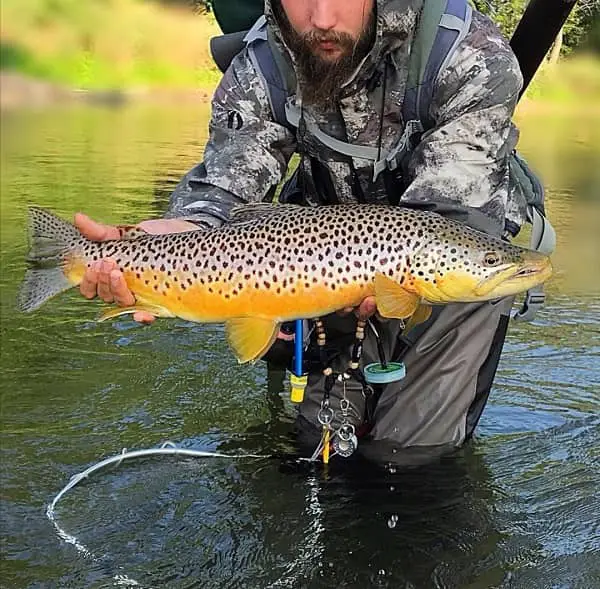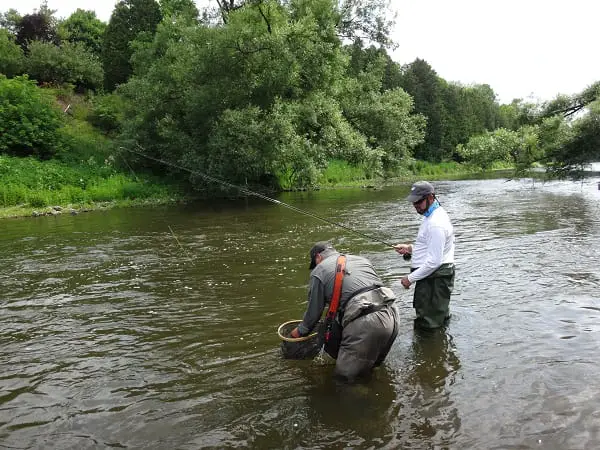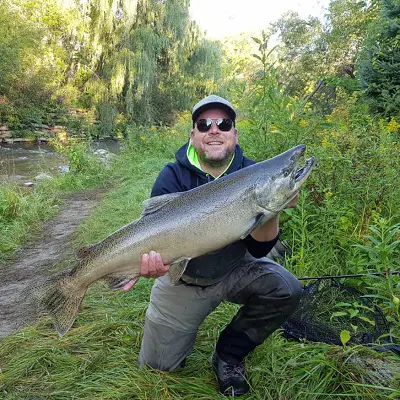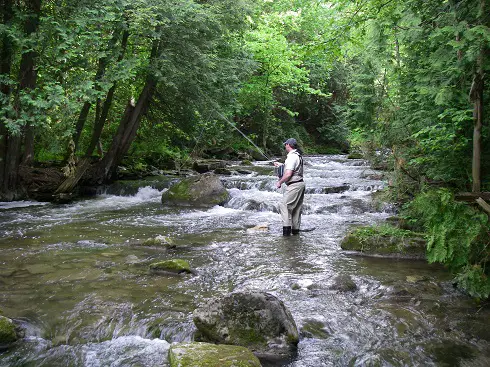Fly Fishing For Salmon on Great Lakes Rivers
I have been a salmon river guide for great lakes salmon for 20 years and I provide the best tips and advice on fly fishing for salmon on the great lakes rivers.
I have been lucky to have been able to fish the rivers of New York, Ontario, Ohio, Pennsylvania, and Michigan for the last 36 years. I have also been the top salmon river guide in my area for over 12 years.
Many of the same methods and flies work in all of these areas if you know when to fish, where to fish, and how to fish.
Just using the right fly does not ensure your success so I will cover the best methods, the best flies, the best gear, and the best rivers to fly fish for salmon in great lakes rivers.
For general information on fishing salmon around the great lakes go to our Fishing For Salmon page.
Fly Fishing For Salmon Can Be The Best Method
Fly fishing for Salmon can be done a few ways and if done right in the right conditions fly fishing can sometimes be the most productive way to catch salmon.
In smaller and shallow rivers fly fishing using indicators or Euro Nymphing can be very effective at landing salmon.
Swinging flies or stripping streamers can also produce some good salmon.
Fly Fishing For Salmon With Indicators
Fly Fishing For Salmon with indicators requires a large indicator, some split shots, and 1 or 2 flies along with the right size leader and tippet.
Why Use Indicators When Fly Fishing For Salmon
Indicator fishing is often the most productive way to fly fish for salmon in many situations along the river.
When the salmon first enter the river they move fast and they don’t slow down much because they are in an unusual and less safe environment and they want to cover as much water and get as far up the river as possible.
Eventually, they will get tired and start to rest or hold for short periods of time at the base of the next rapid or in deeper slower pools. If the water gets too low, especially during high light periods of mid-day they can often hold in these bigger deeper spots all day or until it becomes dark enough that they feel comfortable moving in the shallower water again.
Once the salmon are in these pools and are resting, they are most likely to grab a fly, and the most productive method in these slower and deeper water spots is with an indicator.
A well-presented and slower-moving presentation under an indicator is most likely to get the aggressive and even the less aggressive fish to bite.
The Best Indicators For Salmon Fishing
Some indicators do not float well or may even break your line and many do not allow the angler to get better angles for a better presentation, so using the right indicator is important.
Depending on conditions which include the depth and speed of the spot I want to fish I use two types of indicators when guiding and fly fishing for salmon.
For deeper slower water I choose to go with a taller thin float-style indicator similar to what the float fishing and centerpin guys use. Using this type of indicator can greatly increase the amount of salmon you will catch in this slower deeper water.
This is not the traditional type of indicator you would expect but it works, and it works well, in fact for many reasons that are hard to explain it almost always works better than a traditional indicator if you use it correctly.
The Raven FS 3.8g float allows the angler to present the flies at a better angle for fish that are in slower deeper pools but it can also work the faster water too.
Salmon in these deeper pools can be suspended at different depths and this float is easily adjustable and it still casts OK. Make sure you go with the bigger 3.8-gram float for salmon especially if you are using more than 3 split shots.
Salmon Leader Set-Up and Proper Angles
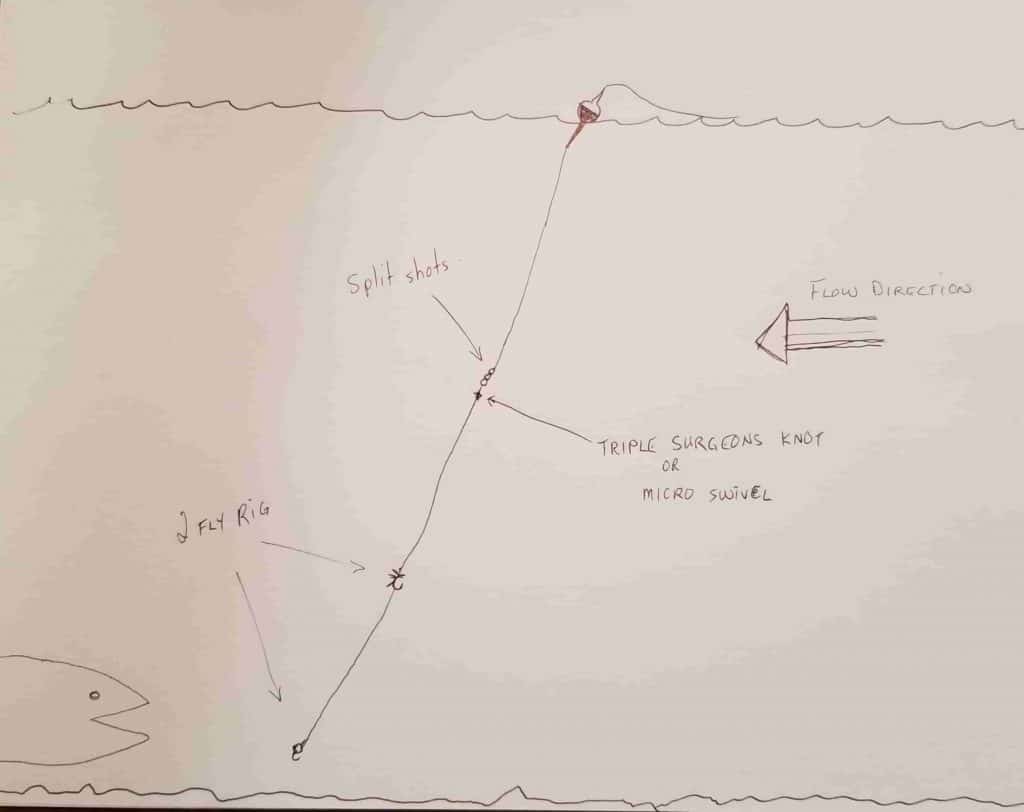
The Raven FS 3.8g float also allows the angler to suspend the flies at multiple levels without dragging the flies across the bottom.
You could even add a third fly where the split shots are in this diagram in case any salmon are suspended high in the water column. You can also add a weight between each fly instead of above the flies.
Even if one fly is dragging across the bottom where most fish do not usually see it the top fly is usually in the strike zone.
You also want to maintain this angle by mending the fly line as far upriver and out towards the indicator as possible. See the Diagram below.
Doing so will create micro drag which will hold back your indicator slightly so you get the angle you see in the picture. You want a straight up-and-down angle with your fly just slightly in front of your float. If your fly is trailing behind your float you will be dragging your fly and you WILL catch LESS salmon.
If you can perfect this angle with proper mending you will greatly increase the amount of salmon you will hook.
Using this suspension style of nymphing instead of the traditional style of dragging your weights and flies across the bottom will always work better and is what I use when fishing myself and with my clients.
The old traditional leader set-up that you may still read or hear about of having the length of leader between the float and the bottom fly being 1 1/2 to 2 times the depth of the water is old school and not as effective as suspending the flies and keeping them off the bottom.
Just watch the underwater video of trout, salmon, and steelhead feeding below the surface and you can clearly see that they feed sideways in a side-to-side manner and they feed up.
Rarely will you ever see them feed down into the rocks to pick up a bait so it only makes sense to keep your flies off the bottom and based on my years of experience it’s always more productive to suspend your flies off the bottom.
How To Indicator Nymph For Salmon Better
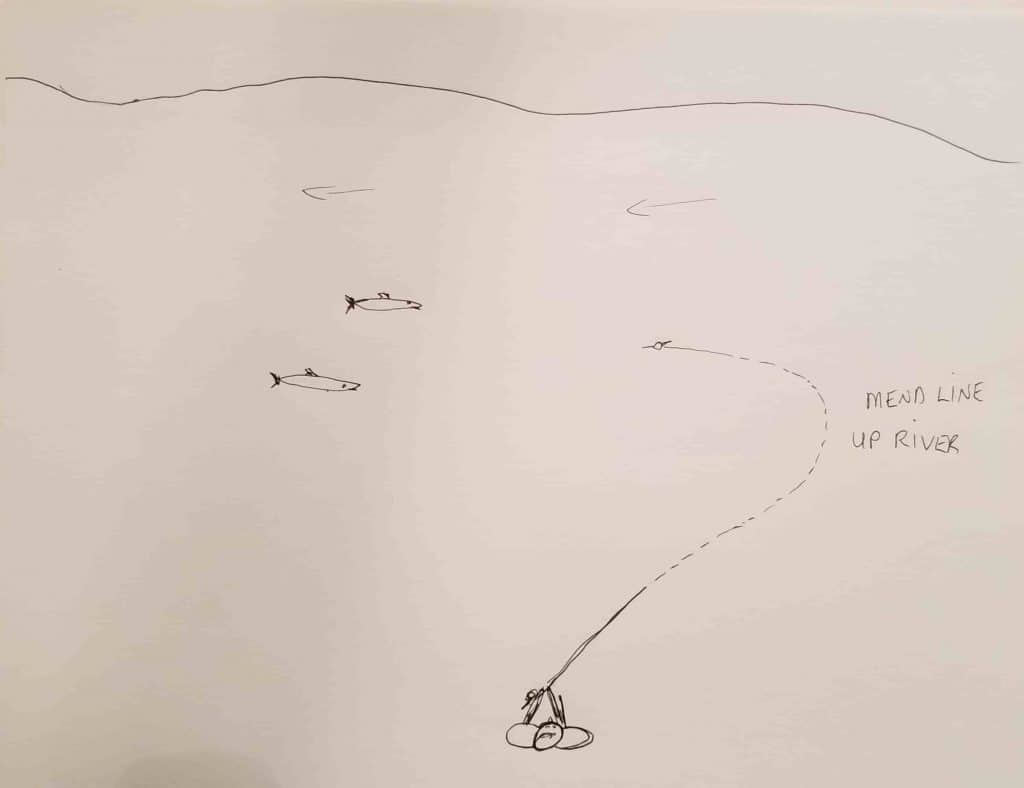
This picture demonstrates an angler that has mended his fly line upriver to achieve the best angle for the leader and a much better presentation overall.
For the more traditional indicator that anglers use, I like the 1 1/2-inch Thill indicators seen here the best.
I prefer a two-tone indicator for teaching and for fishing because it helps the angler determine the angle of their flies. If the angler is wrong you will catch less fish.
I use it in a similar fashion as the other indicator and with the flies suspended and the line mended upriver.
How To Nymph For Great Lakes Salmon
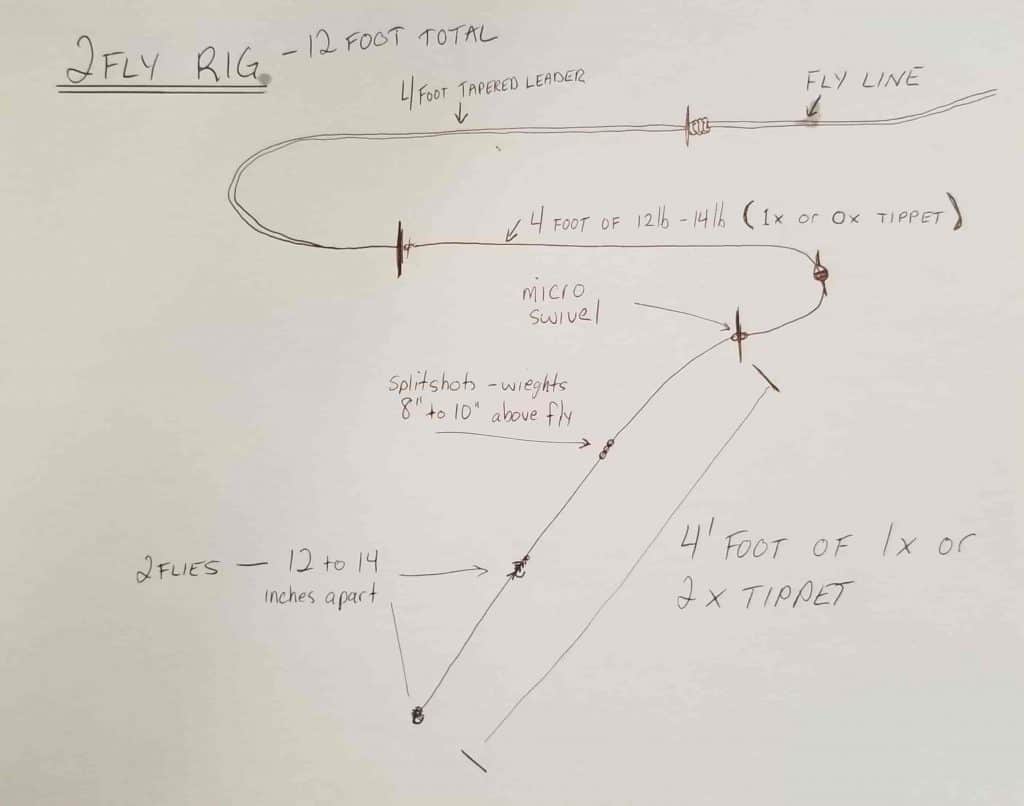
I use this 2-fly leader and indicator rig for fly fishing for salmon and steelhead. When fishing for steelhead I just drop down to 3x tippet or 0.20mm diameter tippet.
There are 3 ways that I tie on drop fly and all 3 seem to work equally well.
The example #1 to the right is super easy but the drawback is that if you want to change the top fly you have two knots to retie. Some anglers will also tie the tag off the eye of the fly which can work too but I never use that method.
The 2nd example is also very easy and allows your fly to hang off the main leader and may provide more movement to the fly. This rarely tangles so don’t worry about that. The disadvantage to this setup is that you can only change the fly on this dropper tag a few times before it gets too short.
The 3rd example that I use is when the dropper in the 2nd example gets too short. This 3rd example is a replacement tag if your tag gets too short and can be added without needing to cut your triple surgeon’s knot. Just make sure you attach it above the triple surgeon’s knot. I have never seen this slip or break. An added advantage is this tag can rotate around the leader which may provide better action.
I keep my flies about 12 inches apart when the water is dirtier and up to 24 inches apart when the water is super clear. For most conditions, my flies are about 16 inches apart.
You can also add a 3rd fly to any of these.
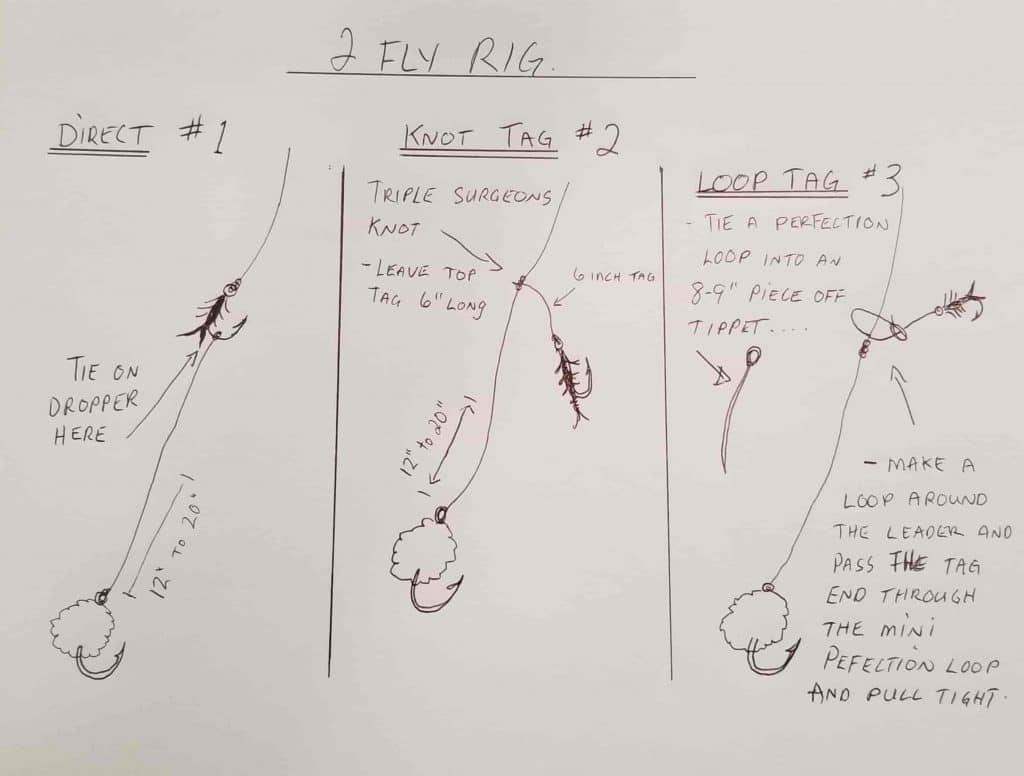
Which Fly To Use
In the diagram, I have a nymph on the top and an egg pattern on the bottom.
My clients often ask which fly they should put on the top and which one on the bottom, how do I choose which goes where?
Although many guides I know put the nymph on the top and the egg on the bottom probably because they believe the eggs tend to roll along the bottom and stay deeper. This could be true but . . . .
My simple answer is to put your confidence fly on the bottom or once you have determined they want more eggs, or more nymphs, or a worm you put that fly, the one they want on the bottom.
FYI, there is no rule saying you can’t run 2 or even 3 of the exact same fly, I do sometimes, especially if they all seem to want I specific pattern.
After all, they are not all tight to the bottom in some cases so putting an egg up high might just work.

